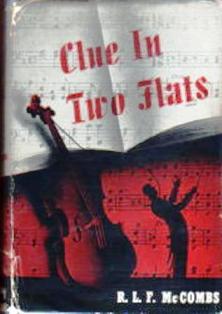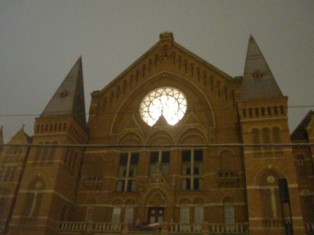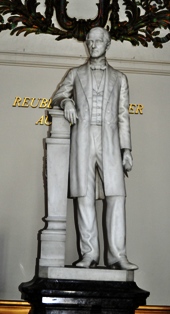
"Clue in Two Flats"
Someone had
to do it. And someone
did – i.e. write a murder mystery about Music Hall.

You can’t
look up at that Gothic façade at night without imaging dastardly deeds afoot. Plus it’s rumored to be haunted.

The book in question is entitled “Clue in Two Flats” by R.L.F. McCombs and was published in 1940 for the then brand new Mystery House imprint for Arcadia House, Inc.
Author McCombs was a music critic in Columbus before becoming program annotator for the Philadelphia Orchestra. (Attempts to learn more about him were unsuccessful because the archives in Philadelphia are closed indefinitely due to “budgetary concerns” and there is no longer an archivist on staff).
According to the dust jacket: “R.L.F. McCombs admits that crime crowds music in his interest. As a music critic on a Columbus Ohio daily (Columbus Citizen), he knew the city’s crime annals as well as the programs of the visiting musical luminaries,” and he might have turned to writing crime novels earlier “if his career in the musical world had not been so crowded and successful.”
McCombs wrote program notes for the Philadelphia Orchestra from 1939-1948, according to Philadelphia Orchestra publicist Darrin T. Britting in response to an e-mail inquiry.
One wonders if McCombs might have been a violinist as well, for the main character in “Clue in Two Flats” is a second violinist in the Cincinnati Symphony Orchestra who, arriving a bit late for rehearsal one morning becomes partial witness to a crime.
The violinist, Richard Deming, is an aural witness. On his way into “the gloomy pile of red brick” (Music Hall) on a frosty December morning, he hears someone furiously playing the piano in the room occupied by the current guest conductor, Max Tuller. After taking his seat in the violin section, Deming learns that Tuller, too, is late. Several fruitless knocks on his door bring no answer, nor does questioning the guard on duty. The impatient musicians – who incidentally detest Tuller – break into the room and find him dead on the floor, a cello A string around his neck. Weeping inconsolably nearby is a young socialite -- daughter, incidentally, of a prominent member of the CSO board.
The investigation, in which Deming pits himself and the son of the Music Hall guard against the Cincinnati police, wends its way from Cincinnati to Dayton to Covington and then to Europe and back via Deming’s acute memory of both the piece he heard being played and more importantly, how it was played on the morning of Tuller’s death.
In jest, the
CSO musicians name Reuben Springer as the culprit -- his marble statue in the
Music Hall foyer, at any rate -- since they know he would never have allowed a
charlatan like Tuller to raise his baton over the CSO. CSO music director Eugene Goossens makes a
“cameo” appearance at the end, as the loose ends are being tied together. Needless to say, Deming is the one who solves
the puzzle, despite being ridiculed by the police detectives. And, oh yes, a CSO cellist had been heard
making disparaging remarks about Tuller at a rehearsal the day before the
killing and Tuller is a notorious womanizer.

At 256 pages, with chapter titles in Italian (Molto Agitato, etc.) it is a page turner and an easy read. If the conducting profession takes a hit, well, musicians have been known to do that to conductors.
Arcadia House went bankrupt in 1948 and was sold, whereupon the mystery line continued sporadically under new ownership until the late 1950s. The book, long out of print, can be found in used bookstores (I located one online at www.alibris.com) and there are several copies in the downtown branch of the Hamilton County Public Library.